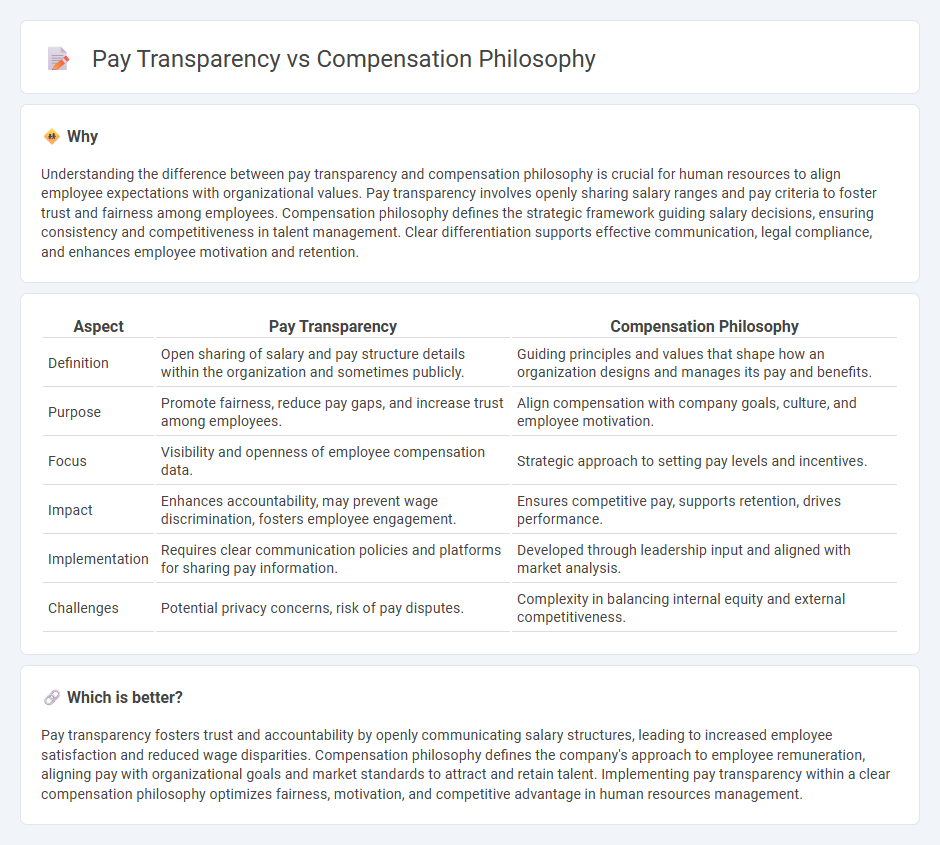
Pay transparency promotes open communication about employee salaries to foster trust and equity, while compensation philosophy defines an organization's strategic approach to salary structures and benefits to align with business goals. Balancing transparency with a clear compensation philosophy ensures competitive pay practices that attract and retain talent. Explore how these concepts shape modern human resource management.
Why it is important
Understanding the difference between pay transparency and compensation philosophy is crucial for human resources to align employee expectations with organizational values. Pay transparency involves openly sharing salary ranges and pay criteria to foster trust and fairness among employees. Compensation philosophy defines the strategic framework guiding salary decisions, ensuring consistency and competitiveness in talent management. Clear differentiation supports effective communication, legal compliance, and enhances employee motivation and retention.
Comparison Table
| Aspect | Pay Transparency | Compensation Philosophy |
|---|---|---|
| Definition | Open sharing of salary and pay structure details within the organization and sometimes publicly. | Guiding principles and values that shape how an organization designs and manages its pay and benefits. |
| Purpose | Promote fairness, reduce pay gaps, and increase trust among employees. | Align compensation with company goals, culture, and employee motivation. |
| Focus | Visibility and openness of employee compensation data. | Strategic approach to setting pay levels and incentives. |
| Impact | Enhances accountability, may prevent wage discrimination, fosters employee engagement. | Ensures competitive pay, supports retention, drives performance. |
| Implementation | Requires clear communication policies and platforms for sharing pay information. | Developed through leadership input and aligned with market analysis. |
| Challenges | Potential privacy concerns, risk of pay disputes. | Complexity in balancing internal equity and external competitiveness. |
Which is better?
Pay transparency fosters trust and accountability by openly communicating salary structures, leading to increased employee satisfaction and reduced wage disparities. Compensation philosophy defines the company's approach to employee remuneration, aligning pay with organizational goals and market standards to attract and retain talent. Implementing pay transparency within a clear compensation philosophy optimizes fairness, motivation, and competitive advantage in human resources management.
Connection
Pay transparency enhances employee trust and engagement by clearly communicating the organization's compensation philosophy, which defines the principles and rationale behind salary structures. This alignment ensures fairness and consistency in wage distribution while supporting talent retention and motivation. Organizations adopting transparent pay practices demonstrate commitment to equity, reinforcing their compensation strategy and fostering a positive workplace culture.
Key Terms
**Compensation Philosophy:**
Compensation philosophy defines an organization's approach to employee pay, aligning salary structures with business goals, market standards, and internal equity to attract and retain talent. It emphasizes principles such as competitiveness, fairness, and performance-based rewards, guiding how compensation decisions are made throughout the company. Explore more to understand how a well-crafted compensation philosophy drives workforce motivation and organizational success.
Total Rewards
Compensation philosophy outlines an organization's approach to employee pay, aligning with business goals and market competitiveness, while pay transparency emphasizes openness about salary structures and decisions to build trust and equity. Both concepts are critical components of a comprehensive Total Rewards strategy, which integrates compensation, benefits, and recognition to attract and retain talent. Explore how aligning compensation philosophy with pay transparency can enhance your Total Rewards framework and drive organizational success.
Market Competitiveness
Compensation philosophy centers on aligning employee pay with organizational goals and values, emphasizing market competitiveness to attract and retain top talent through regular salary benchmarking. Pay transparency involves openly sharing compensation structures and ranges, fostering trust and fairness while maintaining alignment with market rates to ensure equity and motivation. Explore how integrating market competitiveness within both strategies can enhance your organization's talent management effectiveness.
Source and External Links
The Critical Role of a Compensation Philosophy and Strategy in Business Success - A compensation philosophy is a formal statement outlining how a company approaches employee pay and benefits, reflecting its core values and priorities to guide decisions on market positioning, performance rewards, and the balance between base pay, incentives, and benefits.
How to Define Your Compensation Philosophy - A compensation philosophy is a strategic blueprint for compensation decisions that covers not only base pay but also rewards such as bonuses, health insurance, paid time off, and retirement plans, ensuring alignment with the organization's values and mission.
Compensation Philosophy: Creating a Framework - A good compensation philosophy defines a company's strategy to attract, retain, and reward talent through transparent, fair, and compliant practices, including market positioning, pay equality, equity grants, performance incentives, and total rewards.
 dowidth.com
dowidth.com